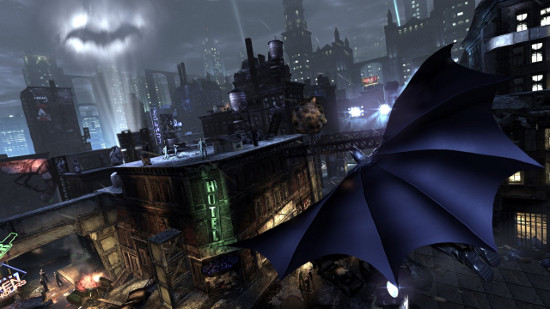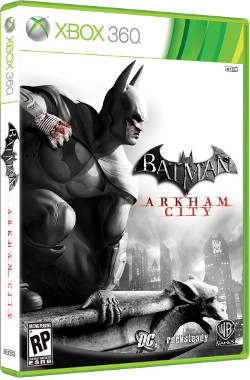
Rocksteady's Batman: Arkham Asylum was a pleasant surprise when it was released in 2009: a video game that, in contrast to the lackluster history of superhero games, was actually good. Arkham Asylum wasn't unique - clearly drawing its combination of rooftop navigation, stealth, and combat from games such as Assassin's Creed - but it deftly applied that formula to the experience of being Batman and inhabiting his world of Gotham City. Batman: Arkham City expands and refines the first game, crafting a new experience that, while never particularly innovative, remains consistently entertaining and a person's best opportunity to feel like the Dark Knight.
Like its predecessor, Arkham City rests on a solid foundation of gameplay focusing on the typical image of Batman: gliding from rooftop to rooftop, swooping down to silently knock out a bad guy, disappearing back into the shadows, listening to nearby criminals panic as they realize they're being hunted by an enemy much smarter and more capable than they. Navigating Arkham City's world is a delight, and although the stealth mechanics are not detailed, it's always satisfying to sneak up behind two thugs and smash their heads together.
This feeling of power is at the core of "being Batman": Ordinary criminals, even in groups, are no match for the Dark Knight; it takes a supervillain such as the Joker to truly threaten him. But because this is a video game, the player will occasionally make a mistake, and when that happens, this feeling of superiority disappears. In many video games, miscues are annoying but part of the experience - perhaps the opportunity for an exciting recovery; slipping up in Arkham City, though, feels like you've failed at being Batman. Despite the game's best efforts, it's unable to reconcile fallible video-game players trying to live up to a nearly infallible character whose strength comes more from skill and intelligence than superpowers.
When you're forced to engage with ordinary enemies, because you screwed up or the plot forces you to, the game's combat system comes into play. Controlling Batman's bashes and dodges is intuitive and kinetic. Each successful strike in a sequence increases Batman's speed and power, which reset if you are struck by an enemy. In a large melee, Batman's maneuvering can quickly escalate into a violent ballet that sees him repeatedly jumping into enemies and using the force of the blow to kick himself toward another foe. It's a satisfying system that feels appropriately powerful, simultaneously responsive and cinematic. Of course, it's also possible to mistime a dodge and be knocked to the ground and mobbed by a gang of thugs, barely escaping by shooting a grapple to a nearby rooftop.
 Most video games overcome the contradiction between myth and live performance by restricting players' freedom and relying more on non-interactive or heavily scripted sequences. Arkham City moves in the opposite direction. While Arkham Asylum was a largely linear, controlled affair, Arkham City offers an open world that players can explore at their leisure, focusing on whatever aspect of the game appeals to them at the moment. The game gives players most of Batman's key tools, from batarangs to explosive gel, right from the start. While there's a sequence of main plot missions, the environment is packed with side missions and incidental encounters.
Most video games overcome the contradiction between myth and live performance by restricting players' freedom and relying more on non-interactive or heavily scripted sequences. Arkham City moves in the opposite direction. While Arkham Asylum was a largely linear, controlled affair, Arkham City offers an open world that players can explore at their leisure, focusing on whatever aspect of the game appeals to them at the moment. The game gives players most of Batman's key tools, from batarangs to explosive gel, right from the start. While there's a sequence of main plot missions, the environment is packed with side missions and incidental encounters.
This world - the titular Arkham City, a large walled-off section of Gotham City transformed into an open-air prison - is the star of the game. While nearly all of Batman's major nemeses make appearances, their presence is largely limited to non-interactive scenes, leaving the gothic, post-apocalyptic ruin of Arkham City to take center stage. It's a phantasmagoric landscape of crumbling ruins, blazing lights, and deep shadows calling to mind not the grim semi-realism of Christopher Nolan's recent films but the surreal, fantastical architecture of Tim Burton's and especially Joel Schumacher's (minus the comic farce).
With the open city populated by gangs of thugs loyal to one or another supervillain, the game offers players an idea of what the night-to-night existence of Batman might be like between stopping supervillains' doomsday schemes. It's in these moments, driven purely by the basic gameplay mechanics - whether moving between missions or just exploring Arkham City - that players feel the most like Batman. Or the most unlike him, when they accidentally stumble upon a thug carrying an assault rifle and find themselves gunned down in a few bursts.
The game, however, never seems entirely comfortable with its openness. It's perhaps understandable that the main missions take place in linear building interiors and contain frequent non-interactive scenes, especially when those scenes feature the likes of the Joker and the Penguin. It's less forgivable when such cinematic sequences see Batman outwitted by foes the player would have no trouble defeating, forcing him to look dumb in order to advance the developers' script. There are also a number of instances when Batman's tools are arbitrarily disallowed in obviously appropriate situations to force players into a scripted, and frequently unintuitive, solution. These occurrences, however, are infrequent blemishes in a lengthy, sprawling, and accomplished game.
Batman: Arkham City is available for Xbox 360 and PlayStation 3 for $59.99. It is scheduled to be released for PC for $49.99 on November 22.
Grant Williams is a developer at Sedona Technologies who hijacked an English degree to study video games. He can be reached at grant.merlin.williams@gmail.com.










